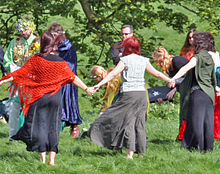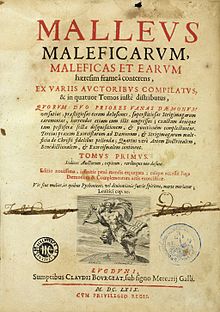Witch

A witch is a person (often female) who practices witchcraft, magic or potions. In modern times, they have become characterised with pointed hats, black cloaks and broomsticks.
Traditionally, the word “witch” was used as an accusation. Witches were accused of bewitching people, or casting spells to control them. In some societies, they were seen as evil, but in others, witches were viewed positively.

Today, followers of Wicca practice witchcraft and worship nature. Some call themselves witches. Note that the practitioners of Wicca are completely unrelated to the historical witches, this article is about.
History[change | change source]
Most indigenous peoples throughout history have had some beliefs about spirits and believed that certain individuals could gain magical powers through herbs or spirits. However, these individuals were not called 'witches' until indigenous people had contact with western ideas. Spirits and people who interacted with them were not always viewed negatively in indigenous societies.
The Malleus Maleficarum[change | change source]
The Malleus Maleficarum, a book published in 1487, fueled panic over witchcraft. It was written by a German Catholic clergyman named Heinrich Kramer. The book was a witch-hunting manual that explained how to persecute witches. It suggested using torture to get accused witches to confess to witchcraft. It also encouraged burning “witches” at the stake.
The new technology of the printing press made it possible for Malleus Maleficarum to be mass-produced. The book was printed 29 times before 1669 - more than any other book except the Bible. As a result, its ideas spread throughout Europe. These ideas were common in Europe for several centuries after the book was published.
The book says that three things are needed in order to create witchcraft: the witch’s evil intentions, the Devil’s help, and God’s permission.[1]
Witch Hunts[change | change source]
Many women throughout Europe and in South America were killed by witch hunts. Historians debate how many women were killed. Because of poor record keeping, it is impossible to know exactly how many victims there were. Also, historians have different opinions about what regions and time frames should be included when estimating how many women were killed in witch hunts.
The entire persecuting legal system - "judges, ministers, priests, constables, jailers, judges, doctors, prickers, torturers, jurors, executioners" - were nearly all male. Meanwhile, the victims were overwhelmingly female. For this reason, some scholars call the witch hunts a "gynocide". In the documentary The Burning Times, Thea Jensen calls this period in history a "Women's Holocaust".
Modern understanding[change | change source]

In the 20th century, many people made a new attempt to understand witchcraft. Some say that witches were in fact wise women who were hunted down by the Catholic Church - mostly for their knowledge about how to treat certain diseases using herbs. Some followers of pagan religions like Wicca began to call themselves witches. This has led to a new understanding of what a “witch” really is.
Heather Marsh has tied the persecution of witches to the fight of church and industry to control "the power of life and death" at a time when industry needed more workers. She also argues the persecution of witches was a fight for centralized power over the peasant rebellions and the ownership of knowledge by medicine and science which forbade the earlier teaching or practices by women and indigenous cultures. She writes that the persecution of witches has colored misogyny since the 1400s.[2]
Silvia Federici tied the witch hunts to a history of the female body in the transition to capitalism.[3]
Witchcraft and accusations of witchcraft are still very common in some parts of West Africa.
Witch crimes in the Malleus Maleficarum[change | change source]

Control of procreation was a constant theme, as was medical knowledge:
- Concerning Witches who copulate with Devils. Why is it that Women are chiefly addicted to Evil superstitions?
- Whether Witches may work some Prestidigatory Illusion so that the Male Organ appears to be entirely removed and separate from the Body.
- That Witches who are Midwives in Various Ways Kill the Child Conceived in the Womb, and Procure an Abortion; or if they do not this Offer New-born Children to Devils.
- How Witches Impede and Prevent the Power of Procreation.
- How, as it were, they Deprive Man of his Virile Member.
- Of the Manner whereby they Change Men into the Shapes of Beasts.
- Of the Method by which Devils through the Operations of Witches sometimes actually possess men.
- Of the Method by which they can Inflict Every Sort of Infirmity, generally Ills of the Graver Kind.
- Of the Way how in Particular they Afflict Men with Other Like Infirmities.
- How Witch Midwives commit most Horrid Crimes when they either Kill Children or Offer them to Devils in most Accursed Wise.
Witches in films and stories[change | change source]
- Hocus Pocus, a film which is about three witches
- The Wizard Of Oz, a book/film which has a witch as the main villain
Famous people accused of witchcraft[change | change source]
- 1431: Joan of Arc. She was burned at the stake on 30 May.
- 1591: Elizabeth of Doberschütz. She was beheaded and burnt outside the gates of Stettin, on 17 December.[4][5]
- 1594: Maria Holl (also known as The Witch of Nördlingen). She was one of the first women to withstand being tortured during her witch trial of 1593-1594. She was eventually cleared of the accusations, which led some people to doubt the righteousness of witch trials. Through her force, Holl rid the town of Nördlingen of their witch craze. She died in 1634, probably from the plague.
- 1612: The Samlesbury witches. In August 1612, they were found not guilty in one of the most famous witch trials in English history. However, ten other people were found guilty and were hanged.
- 1635: Hester Jonas (also called The Witch of Neuss). She was beheaded and burnt on Christmas Eve in 1635, at about 64 years old. The complete proceedings of the trial are still available in Neuss.
- 1663: Anna Roleffes (better known as Tempel Anneke). She was one of the last witches to be executed in Braunschweig. She was beheaded on 30 December.[6]
- 1680: Catherine Monvoisin, a lover of Louis XIV who was close to Marquise the Montespan. She delivered poisons and held black masses for payment. In 1680, she was burnt to death along with some other accused witches on the Place de la Grève in Paris.
- 1692: The witches accused during the Salem Witch Trials in Salem, Massachusetts. Today, Salem is called “the Witch City,” and historical sites related to the witch trials are tourist attractions.
- 1751: Anna Schnidenwind. She was one of the last women to be publicly executed for witchcraft in Germany. On 24 April, in Endingen am Kaiserstuhl, she was strangled to death, then burned.[7]
- 1782: Anna Göldi (or Göldin). She was the last witch to be executed in Europe. Her execution happened in Glarus, Switzerland, in the summer of 1782.
References[change | change source]
- ↑ Russell, Jeffrey Burton (1972). Witchcraft in the Middle Ages. Cornell University Press. p. 232. ISBN 978-0-8014-9289-1.
- ↑ Marsh, Heather (May 2014). "Witches and how they are silenced".
- ↑ Silvia Federici 2004. Caliban and the Witch: women, the body and primitive accumulation.
- ↑ Wehrmann, Martin (1979). Geschichte der Stadt Stettin. Weidlich. p. 264. ISBN 978-3-8128-0033-4.
- ↑ Branig, Hans; Buchholz, Werner (1997). Geschichte Pommerns. Böhlau. p. 158. ISBN 978-3-412-07189-9.
- ↑ Morton, Peter, ed. (2006). The Trial of Tempel Anneke: Records of a Witchcraft Trial in Brunswick, Germany. Barbara Dähms, translator. Ontario: University of Toronto Press.
- ↑ Klaus Graf: Der Endinger Hexenprozess gegen Anna Trutt von 1751 (2012) online.
Other websites[change | change source]
- Some historical notes on the witch-craze from the historian Trevor Roper Archived 2008-07-22 at the Wayback Machine
- Kabbalah On Witchcraft - A Jewish view (Audio) chabad.org
- Jewish Encyclopedia: Witchcraft
- Witchcraft in the Catholic Encyclopedia on (New Advent)
- Witchcraft and Devil Lore in the Channel Islands, 1886, by John Linwood Pitts, from Project Gutenberg
- A Treatise of Witchcraft, 1616, by Alexander Roberts, from Project Gutenberg
- The Witches' Voice 1997-2007 The Witches' Voice Inc
